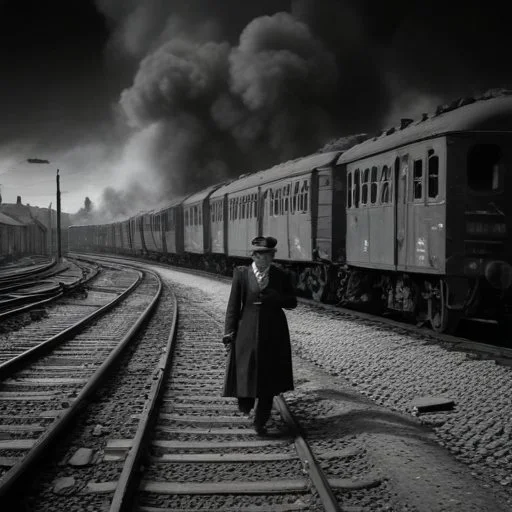The Celle Massacre, also known as the Celle Train Disaster, is one of the most horrific incidents of World War II, where a misguided Allied air raid destroyed a train carrying approximately 4,000 Nazi concentration camp internees, primarily women and children, in Prussian Hanover. The tragedy that unfolded on April 16, 1945, would forever be etched in the annals of history as a senseless and brutal act of violence.
As the Allies advanced on the Western Front, the Nazi regime, in a desperate attempt to evacuate concentration camp prisoners, organized a massive transportation effort to relocate them to other camps. One such train, carrying internees from the Ravensbrück concentration camp, was making its way through Prussian Hanover when the tragedy struck.
On the evening of April 16, 1945, a formation of Allied bombers, likely mistaking the train for a legitimate military target, launched a bombing raid on the train. The attack destroyed several carriages, killing hundreds of internees instantly. Those who survived the bombing were left wounded, shocked, and helpless.
In the aftermath of the bombing, the Nazi guards, who had been escorting the train, turned on the surviving internees. Despite their pleas for mercy, the guards brutally massacred them, often with brutal efficiency. The exact number of casualties is unknown, but estimates suggest that between 300 to 1,000 internees were killed in the massacre.
| Date | Event |
|---|---|
| April 16, 1945 | Allied air raid destroys the train carrying concentration camp internees. |
| April 16, 1945 | Nazi guards massacre surviving internees. |
| April 19, 1945 | Allied forces liberate the area, discovering the aftermath of the massacre. |
The Celle Massacre serves as a stark reminder of the atrocities committed during World War II. It highlights the senseless violence and brutality that characterized the war, particularly towards the end, as the Nazi regime became increasingly desperate.
The Celle Massacre has been the subject of several literary and cinematic works, including the novel "The Train of the Dead" by German author, Helmut Hornung. The incident has also been featured in several documentaries and historical accounts, serving as a poignant reminder of the horrors of war.
"The screams of the dying still echo in my mind... It was a scene from hell." - Anonymous eyewitness account
The Celle Massacre remains a haunting testament to the devastating consequences of war and the importance of remembering the past to prevent such atrocities from happening again.
The Celle Massacre was not an isolated incident. In the final months of World War II, multiple instances of Allied bombings targeting trains carrying civilians and prisoners of war were reported. One such incident occurred on February 13, 1945, when an Allied air raid struck a train carrying approximately 600 prisoners of war, killing over 200. While these incidents were tragic, they underscore the complexity and chaos of war, where mistakes and misidentifications can have devastating consequences.
In the case of the Celle Massacre, the exact circumstances surrounding the bombing are still debated among historians. Some accounts suggest that the train was mistaken for a German military transport, while others argue that it was deliberately targeted as part of a broader campaign to disrupt the Nazi war effort.

Major General Heinrich Borgmann, the commander of the German troops in Hanover, played a pivotal role in the events leading up to the Celle Massacre. Borgmann was a seasoned military officer with a reputation for being ruthless and efficient. Born in 1899, he rose through the ranks of the German military during World War I and later became a key figure in the Nazi regime.
Little is known about Borgmann's personal life, but his military record suggests that he was a loyal and dedicated servant of the Nazi state. His role in the Celle Massacre remains controversial, with some historians accusing him of deliberately sacrificing the lives of concentration camp prisoners to distract from the regime's war crimes.
The Celle Massacre has had a profound impact on German literature and cinema. The incident has inspired numerous novels, poems, and films that explore the trauma and devastation of war. One notable example is the novel "The Train of the Dead" by Helmut Hornung, which tells the story of a young girl's survival of the massacre and her subsequent struggle to come to terms with the trauma.
The massacre has also been featured in several documentaries and historical dramas, including the award-winning film "The Forgotten Victims" (2005), which examines the experiences of concentration camp prisoners during the final months of World War II.

The Celle Massacre highlights the complexities of political decision-making during times of war. The incident raises important questions about the chain of command, military strategy, and the morality of targeting civilian populations.
In the aftermath of the massacre, the Allied commanders faced intense scrutiny for their role in the bombing. While some defended the action as a necessary evil in the fight against the Nazi regime, others condemned it as a reckless and avoidable tragedy.
Historians have long debated the significance of the Celle Massacre in the broader narrative of World War II. Some argue that the incident represents a microcosm of the war's atrocities, highlighting the brutality and senselessness of conflict.
Others contend that the massacre was a unique event, born out of the chaos and desperation of the war's final months. Regardless, the incident serves as a powerful reminder of the human cost of war and the importance of remembering the past to prevent similar atrocities in the future.